|
The thing about tables is they have legs. In fact they have four legs. Four legs each table. One for each corner of the table. If you didn’t have a leg for each corner the table would be wonky and all the things would slide off the corner with no leg, and then you would have to put a bucket under that corner of the table to catch all the things that fell off that corner of the table. There would be little itty bits of paper mixed up with giant jaffas that someone had taken out of their mouths and put all slimy on the table because it’s terribly important to have a wee break in the middle of eating giant jaffas and think perhaps about the moon, mixed up with felt tip pens whose lids had grown little legs and jumped off the table mixed up with cooked rice and cornflakes and all sorts of things. Then, because we have big clomping feet, your father and me would always always always be tripping over the bucket and saying things like, “Ow, ow, ow, Maggie have you done your homework?” Or roaring “Ouch, I told you NOW”. Because when grown-ups are cross about one thing they sometimes pretend it is about something else like their very nice and perfectly splendid and well-behaved children. POOR them. Sometimes you wake up in the morning and sigh a very big sigh, and say , “But who invented maths?” Well, it was actually a grown-up who LOVED tables. He lived in a house with nine rooms and he decided he would build a table for every room. He knew he needed nine table tops. But he didn’t know ANY of his other times tables not EVEN his four times table. When he was trying to figure out how many table legs he needed, he said to himself, nodding wisely, "Oh well, we’ll need about a dozen and a half legs for all that" Whenever he was unsure of any number he always said “Hmm, a dozen and a half” and did his little wise nod. When people asked him how many children he had he said “Ah yes well, a dozen and a half”. When people asked how old he was he said, “It’s funny you should ask! I’ll be a dozen and half next Thursday". Anyway, you can imagine what happened when he made a dozen and half legs for his nine tables. There weren't nearly enough legs to go around all the tables. A couple of the tables had three legs, some had two, and lots of them only had one leg. The poor silly man was always falling over the buckets in different rooms with his big clomping feet, saying “Ouch Ow, Aaagh, brush your teeth now!” to whichever one of his about a dozen and a half children was in the room, until he was almost half mad with sore bruised toes. One day he finally said in a loud, distinguished voice, “Right then, I am inventing maths!” And so he did. As everyone knows the very first thing he invented was the four times table so he could fix all the tables and take all the buckets out of all the rooms and hide them in the car and when he told his family he was going to work. he actually went to the beach with his buckets and built very large and important sandcastles. They had moats. The four time table goes like this. Remeber how I told you that when you multiply even numbers by anything the answer is always even. You can see it's true. Everything in the four times table ends in 2,4,6,8, or 0 which of course means the numbers are even. But if you look closer you can see those end numbers, last digit is always arranged in a particular order. 4,8,2,6,0 You could do the pattern up to gazillion and the last digit of the four times table would always be in the same order. 4,8,2,6,0 And if we arrange them in a grid that is 5 columns across we can see the pattern really clearly, like this. I don't know if that will help you remember the FOUR times table.
To learn it by heart you basically have to do the same thing as with your three times table. Say it over and over to yourself. Say it before you go to sleep and when you wake up. Maybe you'll dream about it and wake up knowing it. But in case you don't learn how to say it quicker than a cucumber without even thinking about it in the next few days, I have another trick that I will write about, which can help you while you're still having to figure it out. Bye bye, Big Mama Clomping Boots
1 Comment
Hooray. We’ve reached a time table you don’t know off by heart. 3 6 9 12 15 18 21 24 27 30 33 I know you know bits of it, but it gets blurry in the middle. One thing you can do is secretly under your breath is to count like this One, two, THREE Four five SIX Seven, eight NINE Ten, eleven, TWELVE ... Then it forms a really nice rhythm and you’ll find yourself enjoying yourself so much you will count all the way 1068. It's quite a good way to remember the 3x table. If you get stuck is to go back to the number one and do a little quiet quiet LOUD quiet quiet LOUD chant to yourself. The LOUD bits are the three times table. Also just say the actual three times table numbers over and over to yourself. Three – Six – Nine – Twelve – Fifteen – Eighteen – Twenty-one –Twenty-four – Twenty-seven –Thirty – Thirty-three Say it ten times now. Say it ten times before bed. Try and get it so you can say it without even thinking what the words mean. Just listen to the rhythm of the words. *** *** *** *** *** *** *** *** *** *** *** A cool three times table pattern Sometimes numbers make really cool patterns. They can help you remember things, and if they don't help you remember they're just cool things to know. Try this. Step 1 Create a three by four grid. That means a table that is three columns across and four rows down. It will look like this: Step 2 In the top row, write in the first three numbers of the three times table. So the answers for 1x3, 2x3 and 3x3. You know 1x3 and 2x3 and if you can't remember 3x3 remember it's 9 which is how old you are. (You will know the 3x table by the time you are 10). Now your table will look like this: Step 3 In the second row, write 1 in every box, in the third row, write 2 in every box, in the bottom row write 3 in every box. Write the numbers to the left of the box. So now your table looks like this: Step 4 Look at the first column which has 3 in the top box. Count backwards from 3 (that is 2, 1, 0 and add that number in the next box, so the second box down has 2 in it, the third box down has 1 in it, and the bottom box has 0 in it. Now your table will look like this: Step 5 Now repeat this with the next two columns - you will be counting backwards from 6 and then from 9. Then your table will look like this: GUESS WHAT????!!!!??? That's the three times table! But wait. There's another maybe even cooler pattern for the three times table If you look at the table you just did again, there is something really cool about it. It only works for the three times table. And it only works out if you put the three times table into a table like this. Can you figure it out? Here's a hint: Now I suggest you write out this table in this pattern as soon as you arrive at anyone’s house because you never know when someone will say I have twenty seven extremely yummy treats and three children but I can’t figure out how many to give to each child so I better throw the whole lot out unless someone can quickly tell me the answer. 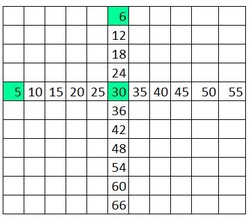 Dear Agent AAMB So here's the thing, bozo. I heard, as well as having to learn the times table, you're having to learn division, and you think it's a total yawn. Well, sometimes you gotta learn stuff, and you might not want to learn stuff, but all the same you got to learn it. And you might think, I already know stuff so why do I have to learn more stuff? I sympathise, but when I was in a similar situation I came up with Ruby Redfort Rule Number 98: Sometimes you know more than you think you know. Take division for example. Once you know your times table you don't really need to learn division. Because you already know it. Take six times five for example. You already know that 6x5=30. That is you know if you had six piles of dragon eggs and each pile had five dragon eggs in it, altogether you would have thirty dragon eggs. At the same time, without even having to learn it you also know that 5x6=30. Yup five piles of dragon eggs with six eggs in each also means 30 altogether. And actually you already know two other things as well. You know that if you had 30 eggs and you put them in six equal piles there would be 5 eggs in each. In maths that looks like this: 30/6=5. That's division. You're dividing dragon eggs into equal piles. You also know that if you had 30 eggs and put them in five equal piles there would be six eggs in each. That looks like 30/5=6. That's division too! You see you know that 6 and 5 and 30 have a special way that they relate to each other. It's pretty good going really. Just by learning one thing i.e. 6x5=30 you ALSO know three other things 6x5=30 therefore 5x6=30 therefore 30/5=6 therefore 30/6=5! It's the same for every thing you learn in the multiplication table, learn one fact and you get an extra three thrown in for free. Trust me, I'm a doctor. Love RR 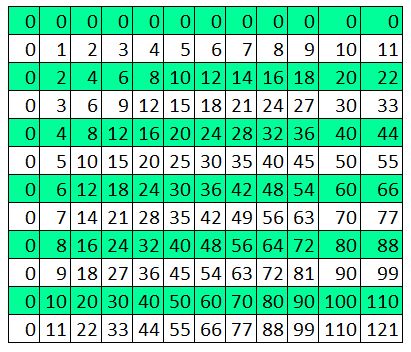 So if we look at the two times table, which as we know is also the list of all the even numbers you'll notice that all the even numbers end in zero, two, four, six, or 8 0, 2, 4, 6, 8. Even numbers always end in 0,2, 4 , 6 or 8. Here's a cool thing, if you times an even number by anything the answer is ALWAYS an even number. Let's take a look. A quick sneaky preview of all the even numbers in the times table. I've highlighted the times table for all the even numbers and you'll see there's only even numbers. This is very handy. If you are ever wondering does 4x4=16 or does 4x4 =46519 you'll know it must be 16 because 16 is an even number and 46519 is an odd number and even numbers multiplied by anything are always even. UNFORTUNATELY the same rule does NOT apply for odd numbers. If you multiply odd numbers by other numbers they can end up odd or even. But there is an odd rule about odd numbers An odd rule about odd numbers An odd number multiplied by an odd number is always odd. Whoa. That's ODD. You better and go and demand a chocolate milkshake from whatever adult is closest to you while you think about that. I only just figured that out. I think maybe I knew it when I was nine but I forgot it. I have to check it for myself. Yup, there we go, all the odd times odd numbers are odd. Excellent.
Here's a little rhyme that doesn't rhyme to help you remember. Even times anything is EVEN Odd times odd is ODD Yes, I KNOW you know the TWO times table. And you know the zero and the one times table. But we have to do things in order otherwise everything will go wonky. It will run around like an orange knitted pig saying wonk wonk, wonk wonk, wonk wonk. I have already told you that ONE times Something = the Something can be written in a special code like this 1a=a Well the two times table looks like this: 2a=(a+a) and you will be astonished to discover that with the three times table it would be 3a=(a+a+a) Doing the two times table is all about doubling. You take whatever number you need to times by two and you double it. Doubling is a very good thing to keep thinking about because it is useful in all sorts of ways. A few of which I will tell you about later. And because you already know the two times table you actually already know a bunch of other things. Doing the two times table is also just listing all the even numbers and missing out the odd numbers. 2, 4, 6, 8, 10, 12, 14, 16, 18, 20, 22 Knowing even numbers is very useful as well. There's quite an interesting thing to know about even numbers and the times tables. I'll talk about it in my next blog post. O-KAY, o-KAY! I can hear you say. I already know my ONE times table. It’s easy. Yeah Yeah, I know you know it. So this will be really short. One times anything is itself. One times two trillion is two trillion. One times seven is seven. There’s a special code people use to explain maths and we can use it to describe the one times table. 1a=a In this code a can mean whatever number you want. And in this code if you’re multiplying things you don’t put the times sign "x" in. You just put the numbers next to each other. _______________ Here’s a secret trick I discovered which will be quick way to remind you of the one times table. It will save you a lot of time. Take whatever number you are multiplying by one, multiply it by 345, add four hundred and sixteen, divide by eight, triple it, times by zero and add your number and BINGO you have your number times one. For example 8 x 345 =2760 2760+416=3176 3176/8 = 397 (that's a divided by sign, have you done them yet?) 397 x 3 (or tripled) = 1191 1191 x 0 = 0 (see previous blog post) 0 + 8 = 8 AMAZING! Now you need never worry about the one times table again.
You’re welcome. Love, The Fat Lady 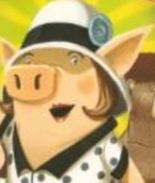 Dear Maggie, Did you know you that you know one part of the 5-billion-and-eighteen times table? Yup, you know 5-billion-and-eighteen times zero. It's ZERO. Because as you already know Zero times anything is ...*exciting pause* ...*drum roll* ...*Maggie rolls her eyes and says 'Very Interesting!' in a tone that means not very interesting at all* ... ... ... ZERO. This is because if you had NO (or ZERO or 0) red velvet cakes and then you had no red velvet cakes again (that makes TWO times ZERO red velvet cakes you would still have ZERO red velvet cakes. And if you had NO red velvet cakes 5-billion-and-eighteen times over you would still have ZERO red velvet cakes and Nanny Piggins wouldn't be very happy about that, would she? And also of course all the number of red velvet cakes in between 1 & 2 & times ZERO also equal ZERO. Here is my picture of 5 billion and eighteen red velvet cakes times ZERO all crammed onto a table. I hope this is helpful. 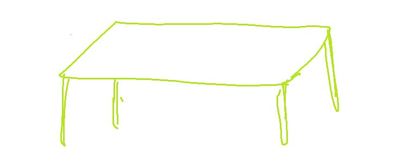 Very complicated picture of the equation 5,000,000,018 x 0 Very complicated picture of the equation 5,000,000,018 x 0 Love Mama / Mrs Loolupants |
Categories
All
Archives
March 2023
(C) Copyright 2012, Mrs Loolupants, All Rights Reserved.
|
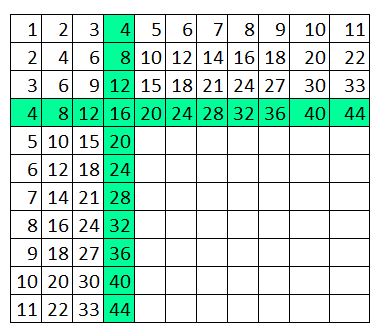
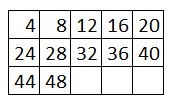
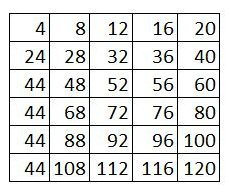
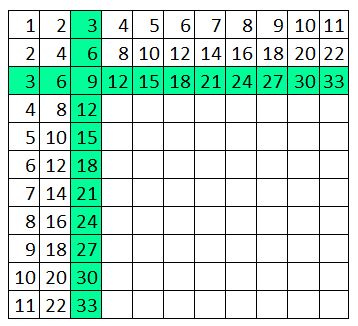
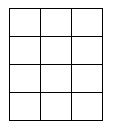


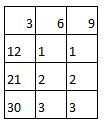
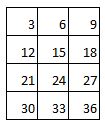
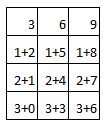
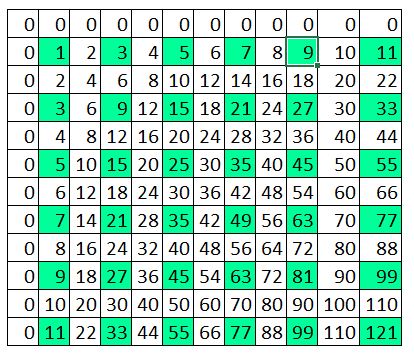
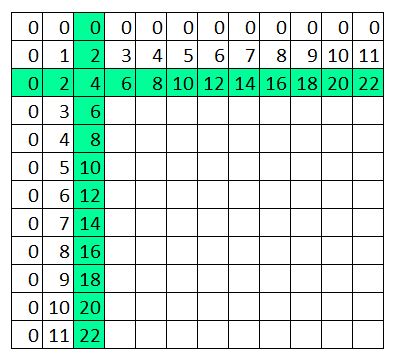

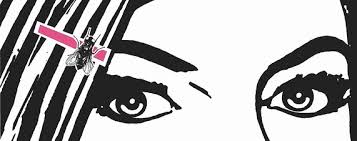
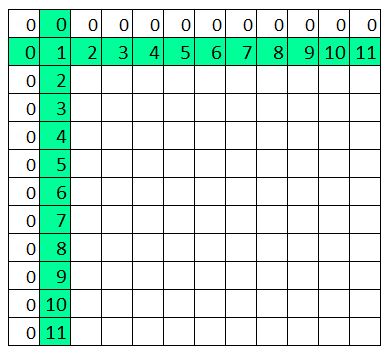
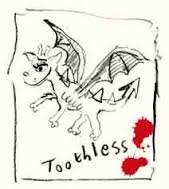



 RSS Feed
RSS Feed
